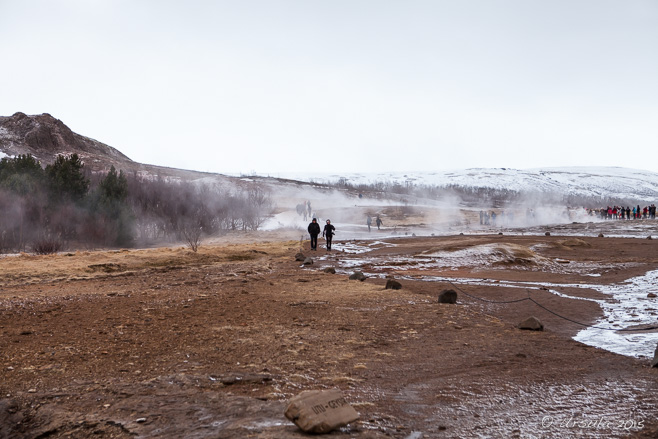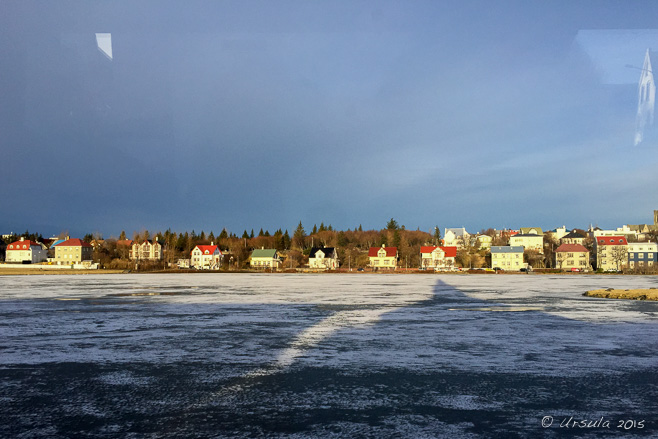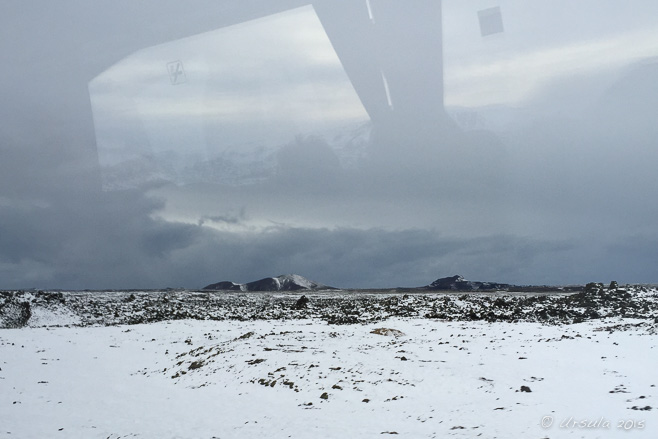
At Litli Geysir
Iceland is home to the first geysers known to modern Europeans. A trip to the geysers in the country’s southwest is an integral part of ‘The Golden Circle’: Iceland’s most popular tourist itinerary.
Iceland, that tiny Nordic island nation in the North Atlantic, sits just barely outside the Arctic Circle and has more glacier-covered land than all of continental Europe. With a terrain that has been ground flat by successive periods of glaciation and rendered relatively tree-less by human predation, the winter landscape looks cold and white and eerily bleak from the air.
But, it is not all as cold as it looks.
The country sits across a rift in continental plates, resulting in a high concentration of volcanoes, hot springs, and geysers – and plenty of almost-free heating and electricity. In fact, about 87% of the heating for buildings and for hot water is geothermal, and approximately 26% of the country’s electricity comes from geothermal power plants.
The capital city Reykjavík (Old Norse for Bay of Smokes) was named for the white “smoke” rising from the hot springs in the area (see: Public Art, Reykjavík). Geysers are so prototypically Icelandic that the word itself came into English in the late 18th century from the Icelandic verb geysa, “to gush”.
The 300 kilometre (190 mile) circuit of highway known as ‘The Golden Circle’, the country’s most popular tour, comprises a visit to the geysers, and stops at the continental divide in the UNESCO-listed Þingvellir National Park and the world-famous Gullfoss waterfall. We combined the tour – which starts and finishes in Reykjavík,with a trip to the naturally-heated Blue Lagoon near the Keflavik Airport, and made a full day of it.
Come along and enjoy Iceland’s unique volcanic landscape.

Morning Light on Lake Tjörnin
Our bus tour starts with a crossing through Reykjavík itself, driving past the partially-frozen Lake Tjörnin in the early morning light. (iPhone6)

Snowy Landscape
As soon as the city is behind us, the view across the Reykjanes Peninsula from the bus windows is flat, snowy, and strewn with small rocks and large boulders. (iPhone6)

Blue Lagoon Entry
Before long we arrive at our first stop: the Blue Lagoon geothermal spa.

Bridge over the Blue Lagoon
The waters rise up through a lava field in Grindavík on the Reykjanes Peninsula: Blue Lagoon itself is man-made and fed by the water output of the nearby geothermal power plant.

Blue Lagoon Visitors’ Building
The waters rise at between 37-40°C (98-104°F), steaming where they meet the cold (0°C; 32°F) air. Leaving the warm waters to reclaim your towel is an adventure!

Blue Waters
The waters are a rich mix of silica, algae and minerals; it is sunlight reflecting off the silica that makes the water look blue.

Blue Café
After a relaxing thermal bath, complete with mineral mud mask, it is important to re-hydrate.

View from the Bus
The Golden Circle Tour runs northeast from Reykjavík … (iPhone)

Snowy Power Lines
… through an open, snowy landscape … (iPhone)

Þingvellir National Park
… into Thingvellir National Park. UNESCO-heritage listed since 2004 for both historic and geologic value, the park is the site of the world’s oldest legislative general assembly, Iceland’s Alþingi (literally: “all-thing”), established in 930. The park also straddles the Continental Divide: where the North American and Eurasian tectonic plates meet.

Down into the Divide
These plates are drifting apart at the rate of more than two centimetres per year. Here in Þingvellir National Park, a walkway leads into the gap, so visitors can functionally walk down between Europe and North America. There are other places nearby (e.g. the Silfra Canyon) where you can scuba dive or snorkel between the continents.

Golden Circle Apartments
Back on the bus, the odd hotel complex stands out in the open landscape. (iPhone)

Gullfoss Overlook
Our next stop is Gullfoss – “Golden Falls” – where a massive volume of water appears to simply disappear into a crevice.

Down to the Gullfoss
The roar of the falls is deafening, and the force of the water causes splash and mist to rise all around.

The Gullfoss
The two-tiered waterfall is quite magnificent – even in the cloudy, overcast conditions we were experiencing.
We escaped the cold and deafening noise and enjoyed our lunch in the on-site Gullfoss Café, which offers hearty hot soups and other food at reasonable (by Icelandic standards!) prices.

At Geysir
The last stop on the circuit is at Haukadalur, home of Iceland’s most famous geysers: Geysir, Strokkur and Litli. Compared to the magnificent geysers in Yellowstone National Park in the USA (see: Old Faithful and Friends; Artist’s Paint Pots; and Mammoth Hot Springs), the geothermal activity here is extremely modest.

Steam Rising
The walkway meanders past Litli Geysir (Little Geyser), around steam vents and mud pools, …

Strokkur – “Churn”
… and on to Strokkur. Eruptions at Great Geysir across the road can be unpredictable, and have even stopped for years at a time.

Strokkur Erupting
Strokkur, on the other hand, erupts reliably every 3-8 minutes, shooting to heights of up to 30 metres.

Litli Geysir
Litli Geysir lives up to it’s name: “Little Geyser”.

Hotel Litli Geysir
Tourist accommodation sits near the geysers in the winter landscape.

Vatnsleysufoss: Faxi Waterfall
On the long drive back to Reykjavík, the tour buses stop briefly at one more waterfall.

If I had been able to chose, I would have picked better weather – but it was an interesting, enjoyable, and informative day, and one I’d recommend to anyone in Iceland for a short visit.
‘Till next time – Happy Rambling!
Photos: 18March2015

























.png)


Great trip knocking off an item on the bucketlist.
😀